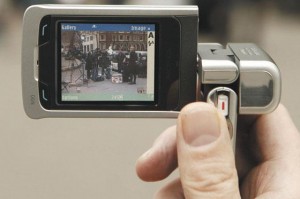Citizen Journalism is a pretty controversial term in Society 2.0. Some journalists argue that journalism is a professional discipline which cannot apply to every individual who posts a “newsworthy” picture online. Some journalists find that there are rules journalists must adhere to, a code of ethics to be followed, and a particular way to explain the information. These journalists find that citizen journalists do not fulfill these requirements and therefore should not be considered journalists. On the other side of the argument, many individuals in Society 2.0 see citizen journalism as an important and beneficial element of the Information Society.
I feel that citizen journalists are  essential to keeping individuals in the Information Society informed. Journalists cannot be everywhere, and sometimes members of society are at the right place and the right time to see or hear something that is important to a news story line. CNN and other news sources are even advertising for individuals to be on the lookout for opportunities to become citizen journalists as to the right.
essential to keeping individuals in the Information Society informed. Journalists cannot be everywhere, and sometimes members of society are at the right place and the right time to see or hear something that is important to a news story line. CNN and other news sources are even advertising for individuals to be on the lookout for opportunities to become citizen journalists as to the right.
 Citizen journalism has become a hot topic on the internet as well with many posts such as this about the subject as well as commentary on the impact of YouTube in this trend. Now with the click of just a few buttons a citizen of Libya can record clips of a protest and distribute them to the entire world on YouTube. Sometimes called ‘homemade’ journalism, this gives the citizens a bigger voice in regions in which their opinions are suppressed.
Citizen journalism has become a hot topic on the internet as well with many posts such as this about the subject as well as commentary on the impact of YouTube in this trend. Now with the click of just a few buttons a citizen of Libya can record clips of a protest and distribute them to the entire world on YouTube. Sometimes called ‘homemade’ journalism, this gives the citizens a bigger voice in regions in which their opinions are suppressed.
For an example of citizen journalism we can look to January 2009 when a US Airways plane had a crash landing in the Hudson River, and no journalists were on the scene to document and witness this event. If it were not for citizen journalists like Ben Vonklemperer, we would not have a first hand report of what the plane looked like in its decent and when it hit the water. Vonklemperer wanted the plane from the 25th floor of his office building and noted that “if someone’s going to land a plane in the water, this seemed the best possible way to do it.” He continued to say that “the way they hit it was very gradual. A very slow contact with the water.” These quotes from a first hand source paint the picture of what occurred that afternoon when no professional journalists were there.
Indeed, once the professional journalists arrived they were able to photograph and report on the scene. But this picture of a ferry providing life vests to the passengers after the plane crash does not really explain the actual plane crash, just the mess afterwards:
On the other hand, this picture taken by a first hand witness, a citizen journalist, perfectly captures the scene:
We see the plane seconds after the landing, and the passengers escaping the plane on inflatable rafts. This picture really is worth 1,000 words on the crash into the Hudson River, while the photograph is worth 1,000 words on the events following the crash. Without citizen journalists on the scene, the new story would not have been complete.


Leave a comment